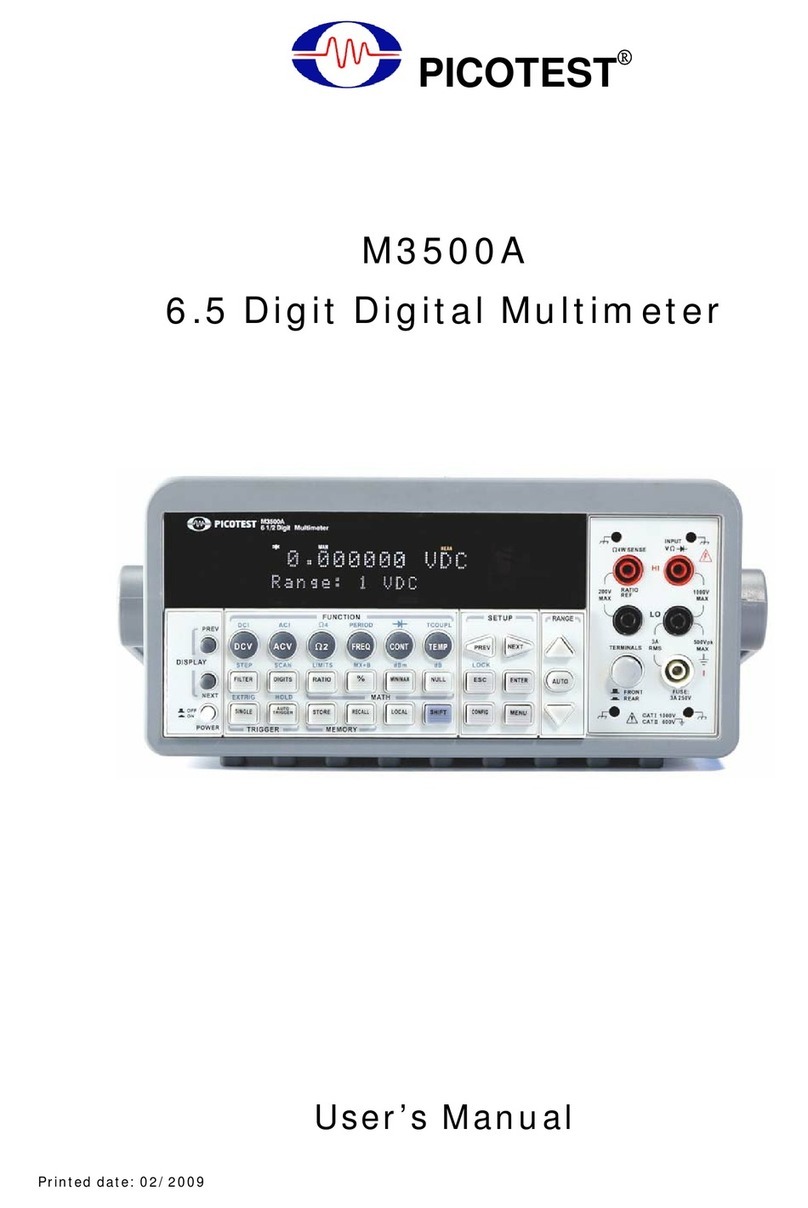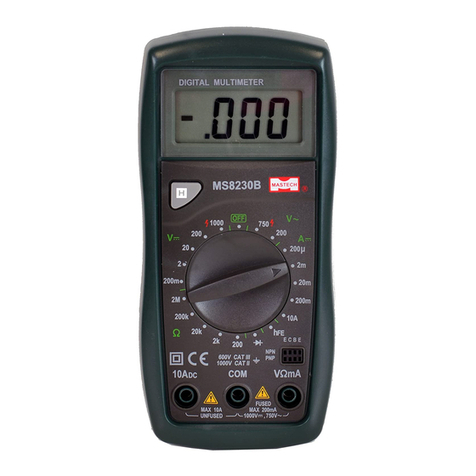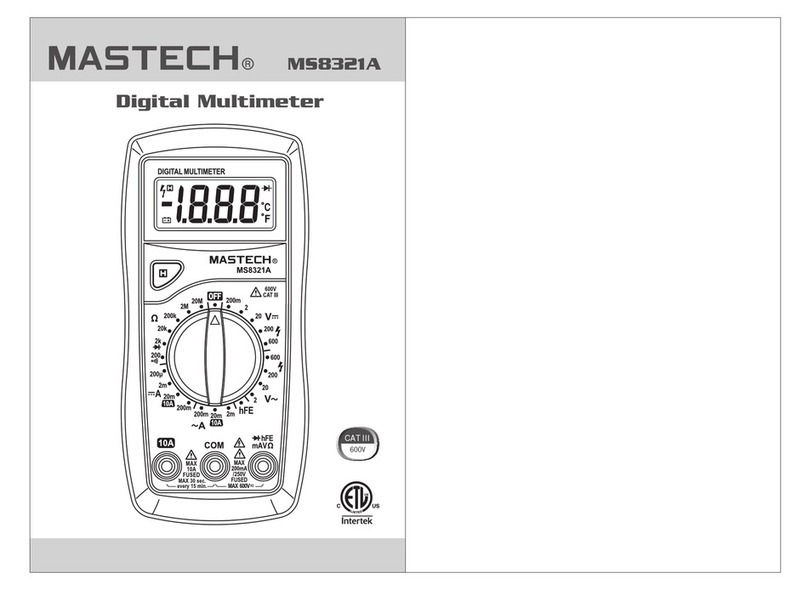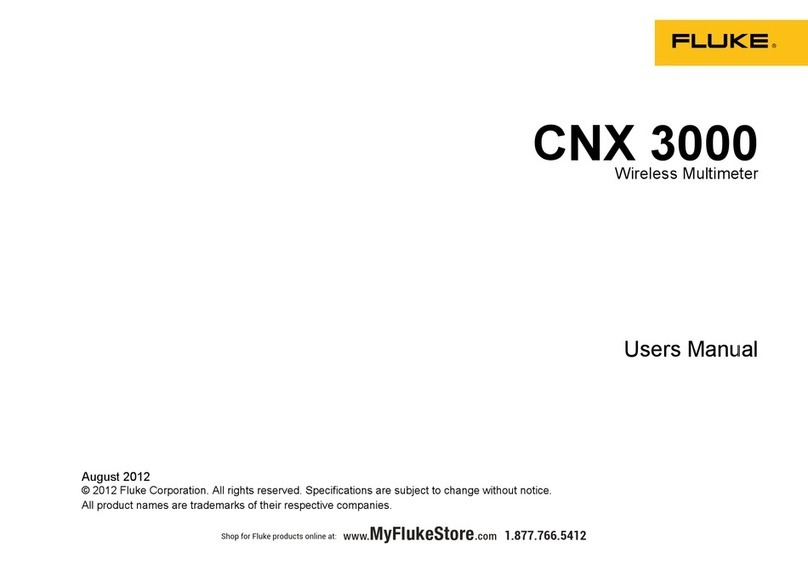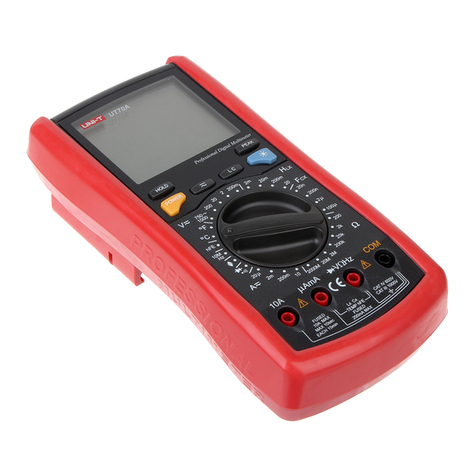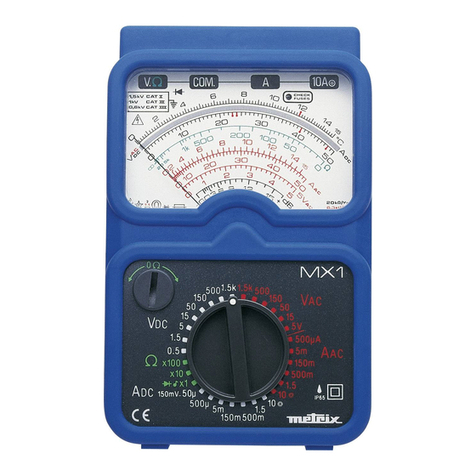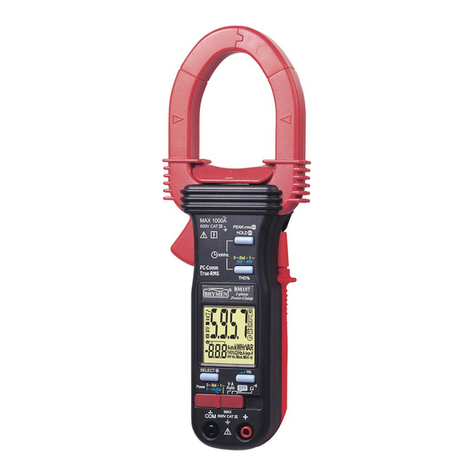Global Specialties PRO-50A User manual

Handheld Digital
Multimeter
PRO-50A

globalspecialties.com 1
Safety Summary
A WARNING statement calls attention to an operating procedure,
practice, or condition, which, if not followed correctly, could result in
injury or death to personnel.
A CAUTION statement calls attention to an operating procedure,
practice, or condition, which, if not followed correctly, could result in
damage to or destruction of parts or the entire product.
To avoid possible electric shock or personal injury, follow these
guidelines:
zUse the meter only as specified in this manual or the
protection provided by the meter might be impaired.
zDo not use the meter or test leads if they appear damaged, or
if the meter is not operating properly.
zAlways use proper terminals, switch position, and range for
measurements.
zTest the meter’s operation on a known voltage before using it
in general. If in doubt, have the meter serviced.
zDo not apply more than the rated voltage, as marked on the
meter, between terminals or between any terminal and earth
ground.
zDisconnect circuit power and discharge all high-voltage
capacitors before testing resistance, continuity, diodes, or
capacitances.
zDo not use the meter around explosive gas or vapor.
zWhen using test leads or probes, keep your fingers behind
the finger guards.
zOnly use test leads and accessories that have the same
voltage, category, and amperage ratings as the meter and
that have been approved by a safety agency.
zDisconnect the test leads from the meter before removing the
battery cover or meter case.
zComply with local and national safety requirements when
working in hazardous locations.
zUse proper protective equipment, as required by local or
national authorities, when working in hazardous areas.
zAvoid working alone.

globalspecialties.com 2
zCheck the test leads for continuity before use. Do not use if
the readings are high or noisy.
zDo not install substitute parts or perform any unauthorized
modifications to this instrument. Return the instrument to Cal
Test Electronics for service and repair to ensure that safety
features are maintained.
zIf the meter is used near noise generating equipment, be
aware that the display may become unstable or indicate large
errors.
zNever ground yourself when taking electrical measurements
zUsing this meter in an environment with a strong radiated
radio-frequency electromagnetic eld (approx. 3 V/m), may
negatively affect the measuring accuracy.
Compliance Statements
Disposal of Old Electrical & Electronic Equipment
(Applicable in the European Union and other European countries
with separate collection systems). This product is subject to
Directive 2012/19/EU of the European Parliament and the
Council of the European Union on waste electrical and
electronic equipment (WEEE), and in jurisdictions
adopting that Directive, is marked as being put on the
market after August 13, 2005, and should not be disposed
of as unsorted municipal waste. Please utilize your local
WEEE collection facilities in the disposition of this product
and otherwise observe all applicable requirements.
The PRO-50A is CE compliant
CE Declaration of Conformity
The power supply meets the requirements of 2006/95/EC Low
Voltage Directive and 2004/108/EC Electromagnetic Compatibility
Directive with the following standards.

globalspecialties.com 3
zLow Voltage Directive: EN61010-1. Safety requirements for
electrical equipment for measurement, control, and laboratory
use-Part 1: General requirements
zEMC Directive: EN 61326-1:2006
Operating Environment
This meter meets IEC 61010-1 2nd Edition standards which dene
four measurement categories:
CAT I
Measurement instruments whose measurement inputs are not intended to be
connected to the mains supply. The voltages in the environment are typically
derived from a limited-energy transformer or a battery.
CAT II Measurement instruments whose measurement inputs are meant to be connected
to the mains supply at a standard wall outlet or similar sources.
CAT III Measurement instruments whose measurement inputs are meant to be connected
to the mains installation of a building.
CAT IV Measurement instruments whose measurement inputs are meant to be connected
to the source of power for a given building.
The instrument may be operated in the following environment:
Measurement Category CAT III, 1000 V
CAT IV, 600 V
Operating Environment 0 °C to 40°C
Storage Humidity 0 – 85% R.H.
Storage Environment -20 °C to +70°C
Pollution Degree Pollution Degree 2

globalspecialties.com 4
Table of Contents Page
1 General Information ................................................5
1. Product Overview......................................................................5
2. Features...................................................................................5
2 Package Contents.....................................................5
3 Product Description..................................................6
1. Front Panel...............................................................................6
2. Display Diagram........................................................................7
4 Using the Digital Multimeter ....................................8
1. DC and AC Voltage Measurements..............................................8
2. DC and AC Current Measurements..............................................9
3. Resistance Measurements........................................................11
4. Diode Measurements...............................................................12
5. Continuity Test........................................................................13
6. Capacitance Measurements......................................................14
7. Transistor Gain Measurements .................................................15
8. Temperature Measurements.....................................................15
9. Frequency Measurements ........................................................16
10. Auto Power-Off.......................................................................16
11. Data Hold Mode......................................................................17
12. Non-Contact AC Voltage Detection ...........................................17
5 Specications .........................................................17
1. General Specications .............................................................17
2. Measurement Specications .....................................................18
6 Maintenance...........................................................21
1. Cleaning.................................................................................21
2. Battery and Fuse Replacement.................................................21
3. Warranty ................................................................................22
4. Calibration and Repair .............................................................22

globalspecialties.com 5
1 General Information
1. Product Overview
The Global Specialties PRO-50A Handheld Digital Multimeter
provides standard measurement functions, which include AC and
DC voltage, AC and DC current, resistance, capacitance, diode, and
continuity.
2. Features
z3½ Digit display resolution
zDC Voltage measurement up to 1000 V
zAC Voltage measurement up to 750 V
zAC and DC Current up to 10 A
zFrequency measurements
zTemperature measurements
2 Package Contents
Please inspect the instrument mechanically and electrically upon
receiving it. Unpack all items from the shipping carton, and check
for any obvious signs of physical damage that may have occurred
during transportation. Report any damage to the shipping agent
immediately. Save the original packing carton for possible future
reshipment. The package includes the following:
zPRO-50A handheld digital multimeter
z1x User manual
z1x Test leads
z1x “K” type bead thermocouple
z1x Special multi-function socket

globalspecialties.com 6
3 Product Description
1. Front Panel
1
2
3
4 5
6
7
8
9
1011
Figure 1. Front Panel Diagram

globalspecialties.com 7
Front Panel Description
1. Display: Displays the measured values, selected function mode, and annunciators.
2. Power Button: Turns the meter on or off.
3. 10 A: The positive input terminal for up to 10 A current measurement.
4. mAhFE, TEMP : The positive input terminal for up to 400 mA, as well as for capacitive
and temperature measurements.
5. COM: The negative (ground) input terminal for all measurement modes. Connection is
made to it using the black test lead.
6. VΩHz : The positive input terminal for voltage, ohms, frequency and diode
measurements. Connection is made using the red test lead.
7. Function/Range Rotary Switch: Selects the function and desired range.
8. Backlight: Press to activate LCD backlight.
9. HOLD: Displays the current value on the display even if the leads are removed from device
under test. Pressing the button again returns to current reading measurement mode.
10. AC Voltage Sensor: Sensor for non-contact AC voltage detection.
11. AC Voltage Indicator: Indicator LED for AC voltage ≥110 Vrms.
2. Display Diagram
1 2 3 4 5 6
7
8
9
10
11
12
Figure 2. Display Diagram

globalspecialties.com 8
Display Description
1. Indicates use of the highest voltage settings
2. The meter is in data hold mode
3. The meter is in diode test mode
4. The meter is in continuity check mode
5. The meter is in transistor gain mode
6. The meter is in temperature mode
7. Units of measure
8. Indicates range
9. Low battery indicator. WARNING. To avoid false readings which could lead to electric shock
or instrument damage, change the battery as soon as this indicator appears.
10. Alternating current
11. Indicates negative value
12. Direct current
4 Using the Digital Multimeter
With no signal present, set the rotary switch to the desired
measurement function. Ensure proper insertion of the test leads so
they correspond with the type of measurement you wish to perform.
When connecting the test leads to the circuit or device, connect the
COM test lead (black) before connecting the live lead (red). When
removing the test leads, remove the live lead rst.
WARNING
To avoid electric shock, injury, or damage to the meter, disconnect
circuit power and discharge all high-voltage capacitors before
testing resistance, continuity, diodes, or capacitance.
CAUTION:
Always connect the test leads to the meter’s inputs rst before
connecting the DUT to avoid potential shock hazard.
1. DC and AC Voltage Measurements
The meter’s DC voltage ranges, , are 200 mV, 2 V, 20 V, 200 V,
and 1000 V. The AC voltages ranges, , are 2 V, 20 V, 200 V, and
750 V. Turn the rotary switch to the corresponding symbol for the

globalspecialties.com 9
measurement you would like to perform.
Follow these steps to make a measurement:
1. Connect the negative (-) side with the black test lead to
the COM input.
2. Connect the positive (+) side with the red test lead to the
VΩHz input.
3. Probe with the test leads to the DUT and record the
measured reading on the display.
10A COMmAhFE
TEMP VΩHz
Figure 3. Connection for AC or DC Voltage Measurement
2. DC and AC Current Measurements
WARNING
To avoid personal injury or damage to the meter:
zNever attempt to make in in-circuit current measurement
when the open-circuit potential to earth is >600 V.
zCheck the meter’s fuse before testing.
zUse the proper terminals, switch position, and range for your
measurement.
zNever place the probes in parallel with a circuit or component
when the leads are plugged into the current terminals.
The meter’s DC current ranges, , are 20 mA, 200 mA, and 10
A. The meter’s AC current ranges, , are 20 mA, 200 mA, and 10
A. Turn the rotary switch to the corresponding symbol for the
measurement you would like to perform.
Follow these steps to make a measurement:

globalspecialties.com 10
1. Connect the black test lead to the COM terminal and the
red test lead to the mA terminal for a maximum of 200 mA.
For a maximum of 10 A, move the red test lead to the 10 A
terminal.
2. Turn circuit power off.
3. Break the circuit path to be tested. Connect the black
test lead to the more negative side of the break; connect
the red test lead to the more positive side of the break.
(Reversing leads will give a negative reading, but will not
damage the meter.)
4. Turn on the power of the measured circuit and read the
display. Be sure to note the measurement units at the
right side of the display (mA or A). When only the gure
“1” is displayed, it indicates an overrange situation and the
higher range has to be selected.
5. Turn off the power of the measured circuit and discharge
any high voltage capacitors. Remove the test leads and
reconnect the test circuit.
Figure 4. Connection for Low AC or DC Current Measurement
10A COMmAhFE
TEMP VΩHz
A
WARNING
Do not connect more than 400 mA DC current across the mA input
terminal or the protection fuse will be tripped.
10A COMmAhFE
TEMP VΩHz
A
Figure 5. Connection for Higher AC or DC Current Measurement

globalspecialties.com 11
WARNING
Do not connect more than 10 A DC current across the 10 A input
terminal or the protection fuse will be tripped.
3. Resistance Measurements
The meter’s resistance ranges, Ω, are 200 Ω, 2 kΩ, 20 kΩ, 200 kΩ,
2 MΩ, 20 MΩ, 200 MΩ. Turn the rotary switch to the proper range.
Follow these steps to make a measurement:
1. Connect the black test lead to the COM input. Note that
the measurement voltage polarity is positive on COM
input.
2. Connect the red test lead to the VΩH input.
3. Probe with the test leads to the DUT and record the
measured reading on display.
10A COMmAhFE
TEMP VΩHz
Resistance
Figure 6. Connection for Resistance Measurement
WARNING
Do not apply more than 1000 V DC across the terminals or they will
be damaged.
Tips for resistance measuring:
zThe measured value of a resistor in a circuit is often different
from the resistor’s rated value. This is because the meter’s
test current flows through all possible paths between the
probe tips.
zIn order to ensure the best accuracy in measurement of low
resistance, short the test leads before measurement and note

globalspecialties.com 12
the resistance. This value represents the resistance of the test
leads and should be subtracted.
zOn 20 MΩ and 200 MΩ ranges, the meter may take a few
seconds to stabilize the reading. This is normal for high
resistance measuring.
zWhen the input is not connected, i.e. at open circuit, the gure
“1” will be displayed indicating an overrange condition.
4. Diode Measurements
Use the diode test to check diodes and other semiconductor
devices. The diode test sends a current through the semiconductor
junction, and then measures the voltage drop across the junction. A
good silicon junction drops between 0.5 V and 0.8 V.
CAUTION
Always connect the test leads to the instrument inputs rst before
connecting the DUT to avoid potential shock hazard.
Follow these steps to make conduct a diode test:
1. Set the rotary switch to the diode range, .
2. Connect the black test lead to the COM input.
3. Connect the red test lead to the VΩHz input.
4. For forward-bias readings on any semiconductor
component, place the red test lead on the component’s
anode and place the black test lead on the component’s
cathode.
5. The meter will show the approximate forward voltage of
the diode. If the test lead connection is reversed, only the
gure “1” will be displayed.
6. In a circuit, a good diode should still produce a forward
bias reading of 0.5 V to 0.8 V; however, the reverse-bias
reading can vary depending on the resistance of other
pathways between the probe tips.

globalspecialties.com 13
10A COMmAhFE
TEMP VΩHz
Diode
Figure 7. Connection for Diode Measurement
WARNING
Do not apply more than 1000 V DC across the terminals or they will
be damaged.
5. Continuity Test
Continuity is a complete path for current ow. The meter’s continuity
test is available to check for open/shorts of the circuit. The beeper
sounds if a circuit is complete. To test for continuity:
1. Set the rotary switch to the continuity range, .
2. Connect the black test lead to the COM input.
3. Connect the red test lead to the VΩHz input.
4. Connect the test leads to the resistance in the circuit being
measured.
5. When the test lead to the circuit is below 30 Ω, a
continuous beep will sound, thus indicating a closed
circuit.
10A COMmAhFE
TEMP VΩHz
Continuity
Figure 8. Connection for Continuity Test

globalspecialties.com 14
WARNING
Do not apply more than 1000 V DC across the terminals or they will
be damaged.
6. Capacitance Measurements
Capacitance is the ability of a component to store an electrical
charge. The unit of capacitance is the farad (F). Most capacitors are
in the nanofarad to microfarad range.
The meter’s capacitance ranges, , are 20 nF, 200 nF, 2 µF, and
200 µF. Turn the rotary switch the
corresponding symbol for the measurement you would like to
perform.
WARNING
To avoid electrical shock and/or damage to the instrument,
disconnect circuit power and discharge all high-voltage capacitors
before measuring capacitance. Use the DC voltage function to
conrm that the capacitor is discharged.
CAUTION
Always connect the test leads to the instrument inputs rst before
connecting the DUT to avoid potential shock hazard.
Follow these steps to make a capacitance measurement:
1. Connect the black test lead to the COM input. This will
connect to the negative side of your capacitor.
2. Connect the red test lead to the input. This will connect
to the positive side of your
capacitor.
3. Probe with the test leads to the DUT and take the
measured reading on display.
4. The meter may take a few seconds to stabilize the
reading. This is normal for high capacitance measuring.
5. To improve the accuracy of measurements less than 20
nF, subtract the residual capacitance of the meter and
leads.

globalspecialties.com 15
Figure 9. Connection for Capacitance Measurements
Capacitor
10A COMmAhFE
TEMP VΩHz
WARNING
Do not apply more than 1000 V DC across the terminals or they will
be damaged.
7. Transistor Gain Measurements
WARNING
To avoid electrical shock and/or damage to the instrument, do not
apply more than 250 VDC or 250 ACrms between the hFE terminal
and the COM terminal.
Using the included multi-function socket, DC transistor gain (hFE)
can be measured. Follow these steps to make hFE measurements:
1. Set the rotary switch to hFE range.
2. Connect the “COM” plug and “+” plug of the special
multi-function socket to the COM and hFE terminals,
respectively, on the meter.
3. Determine whether the transistor to be tested is NPN or
PNP type and locate the emitter, base, and collector leads.
4. Insert leads of the transistor into the proper holes of the
special multi-function socket: “c” for collector, “b” for base,
and “e” for emitter.
5. The meter will show the approximate hFE value for the
test condition of base current 10 µA DC and Vce 2.8 VDC.
8. Temperature Measurements
WARNING
To avoid electrical shock, do not use this instrument when voltages
at the measurement surface exceed 60 VDC or 24 VACrms.

globalspecialties.com 16
Follow these steps to make a temperature measurement.
1. Set the rotary switch to the TEMP range. The LCD will
show the current environmental temperature.
2. Connect the “COM” plug and “+” plug of the special multi-
function socket to the COM and TEMP terminals.
3. Insert the “K” type thermocouples into the multi-function
socket. Take care to observe the correct polarity.
4. Touch the object under test with the thermocouple probe
for measurement.
5. Take measured reading (in °C) from the display.
9. Frequency Measurements
WARNING
To avoid electrical shock hazard and/or damage to the instrument,
do not measure frequency on high voltage (>250 V).
Follow these steps to make a frequency measurement.
1. Turn the rotary switch to the frequency range, 20kHz.
2. Connect the black test lead to the COM input.
3. Connect the red test lead to the VΩHz .
4. Connect the test leads to the circuit being measured.
5. Read the displayed value.
Frequency
10A COMmAhFE
TEMP VΩHz
Figure 10. Connection for Frequency Measurement
10. Auto Power-Off
Auto power off occurs approximately after 15 minutes when there
has been no interaction with the meters knobs or buttons.

globalspecialties.com 17
11. Data Hold Mode
Data HOLD mode makes the meter stop updating the display. The
data HOLD function can be canceled by changing the measurement
mode, or by pushing the HOLD key again. To enter and exit the data
HOLD mode:
6. Press HOLD key. This xes the display on the current
value. His displayed.
7. A second short press returns the meter to normal mode.
12. Non-Contact AC Voltage Detection
Hold the meter so that the meter’s top is vertically and horizontally
centered and contacting the conductor. Where there is AC voltage
>100 VACrms the LED indicator will light up.
WARNING
Even even there is no indication, voltage may still exist. Do not rely
on the non-contact voltage detector with shielded wire. Detection
operation may be subject to socket design, insulation thickness and
type.
5 Specications
1. General Specications
zDisplay: 3½ digit LCD with automatic indication of functions
and symbols
zPolarity: Automatic, (-) negative polarity indication
zOverrange Indication: LCD with display “1”
zLow Battery Indication: Indicates current capacity of battery.
zWhen the battery is low, will show in the display.
zSample Rate: 3 times/second for digital data
zOperating Environment: 0°C to 40°C at < 80% R.H, < 10°C
noncondensing
zStorage Environment: -10°C to 60°C at < 70% R.H (battery
removed)
zTemperature Coefficient: 0.1×(specified accuracy)/°C. (<18°C
or >28°C)
zAltitude: <6561.7 ft (2000 m)

globalspecialties.com 18
zPower: Single 9 V battery
zDimensions (H × W × D): 188 x 92 x 50 mm
zWeight: Approx. 380 grams (including battery)
2. Measurement Specications
Accuracy is specied for one year after calibration, at operating
temperatures of 18°C to 28°C, with relative humidity at 0% to 75%.
Accuracy specifications take the form of: ±(%of Reading + Number
of Least Significant Digits).
a. DC Voltage
Range Resolution Accuracy
200 mV 0.1 mV ±(0.5% of rdg + 1 digit)
2 V 1 mV
20 V 10 mV
200 V 100 mV
1000 V 1 V ±(0.8% of rdg + 2 digit)
Input Impedance: 10 MΩ
Max Input Voltage: 250 VDC or ACrms for 200 mV range and 1000 VDC or 750 ACrms for other
ranges.
b. AC Voltage
Range Resolution Accuracy
2 V 1 mV
±(0.8% of rdg + 3 digits)
20 V 10 mV
200 V 100 mV
750 V 1 V ±(1.2% of rdg + 3 digits)
Input Impedance: 10 MΩ
Max Input Voltage: 250 VDC or ACrms for 200 mV range and 1000 VDC or 750 ACrms for other
ranges.
Frequency Range: 40 Hz-400 Hz
Response: Average, calibrated in rms of sine wave
c. DC Current
Range Resolution Accuracy
20 mA 10 µA ±(0.8% of rdg +1 digit)
200 mA 0.1 mA ±(1.5% of rdg +1 digit)
10 A 10 mA ±(2.0% of rdg +5 digits)
Overload Protection: Fuse (FF400mA/1000V) and 10 A range fuse (FF10A/500V)

globalspecialties.com 19
Max Input Current: 200 mA DC or 200 mA ACrms for mA range
10A DC or 10 A ACrms for 10 A range
For measurements >5 A, 10 seconds maximum ON to measure, 1 minute OFF. Above 10 A
unspecied.
d. AC Current
Range Resolution Accuracy
20 mA 10 µA ±(1.0% of rdg +3 digits)
200 mA 0.1 mA ±(1.8% of rdg +3 digits)
10 A 10 mA ±(3.0% of rdg +7 digits)
Overload Protection: Resettable fuse (FF400mA/1000V) and 10 A range fuse (FF10A/500V)
Max Input Current: 200 mA DC or 200 mA ACrms for mA range
10A DC or 10 A ACrms for 10 A range
For measurements >5 A, 10 seconds maximum ON to measure, 1 minute OFF. Above 10 A
unspecied.
Response: Average, calibrated in rms of sine wave.
e. Resistance
Range Resolution Accuracy
200 Ω 0.1 Ω ±(0.8% of rdg + 3 digits)
2 kΩ 1 Ω
±(0.8% of rdg + 1 digit)
20 kΩ 10 Ω
200 kΩ 100 Ω
2 MΩ 1 kΩ
20 MΩ 10 kΩ ±(1.0% of rdg + 2 digits)
200 MΩ 0.1 MΩ ±(5.0% of rdg + 10 digits)
Overload protection: 250 VDC or 250 VACrms
Open Circuit Voltage: <700 mV
f. Continuity Test
Audible Threshold
≤30 Ω
Test Current: Approx. 1 mA
Reversed DC Voltage: Approx. 2.8 V
Overload Protection: 250 VDC or 250 VACrms
g. Diode Test
Range Forward DC Current Reversed DC Voltage
1 mV 1 mA 2.8 V typical
Overload Protection: 250 VDC or 250 VACrms
Table of contents
Popular Multimeter manuals by other brands

PCE Health and Fitness
PCE Health and Fitness PCE-HDM 7 user manual
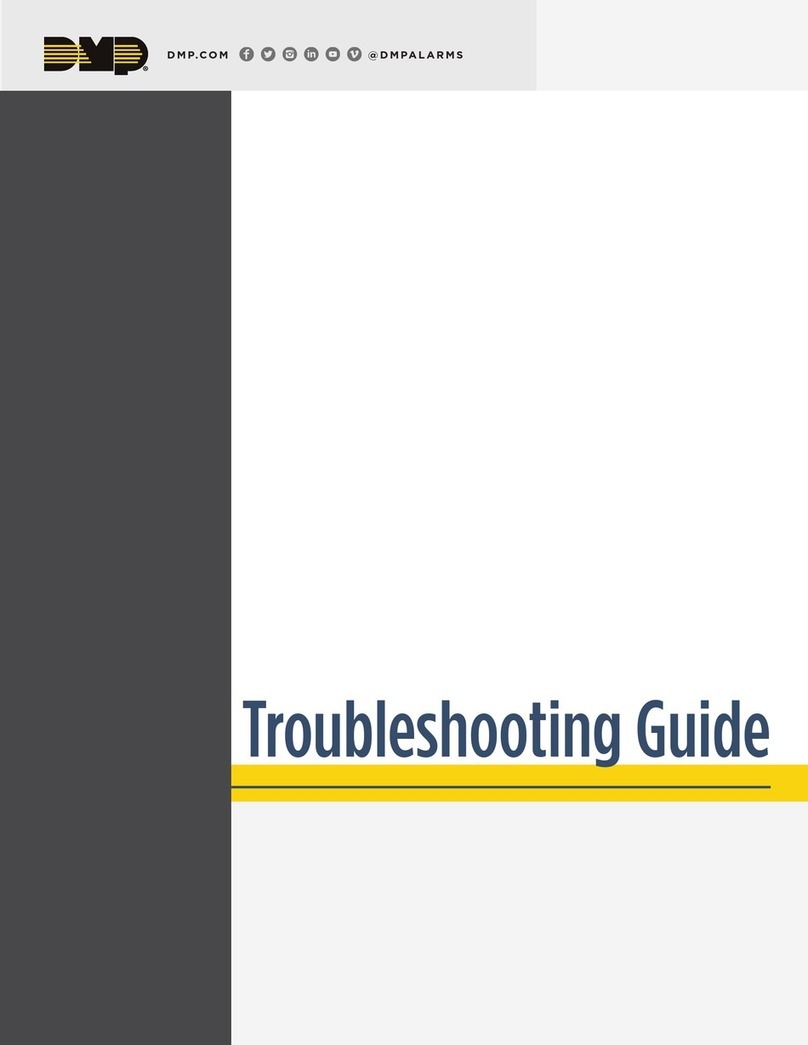
DMP Electronics
DMP Electronics XR Series troubleshooting guide
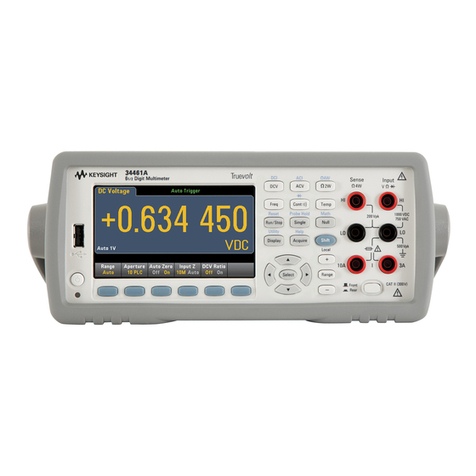
Keysight Technologies
Keysight Technologies Truevolt Series Security features and volatility documentation
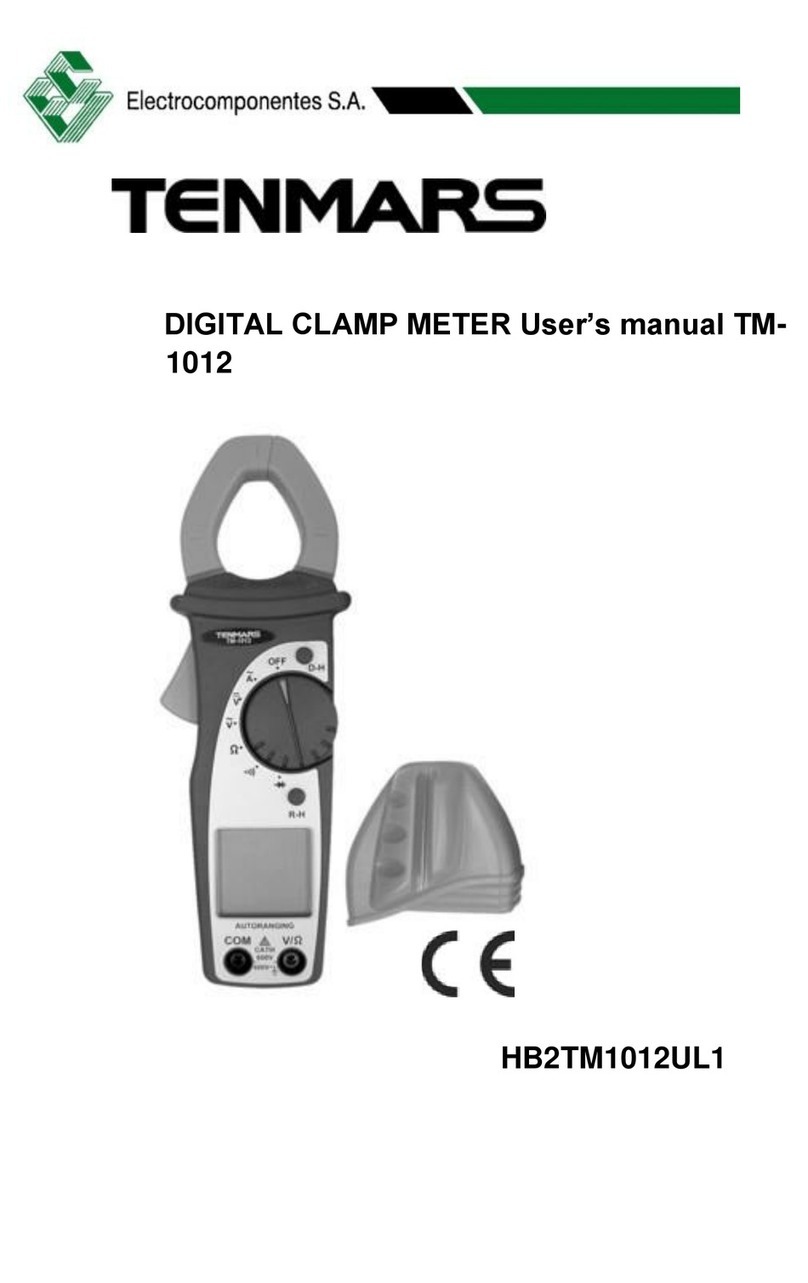
Tenmars
Tenmars TM-1012 user manual
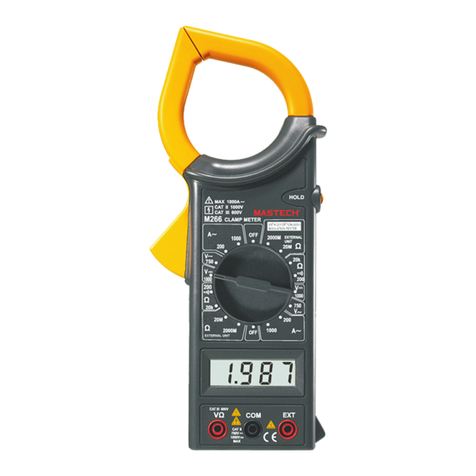
Mastech
Mastech M266 Series user manual
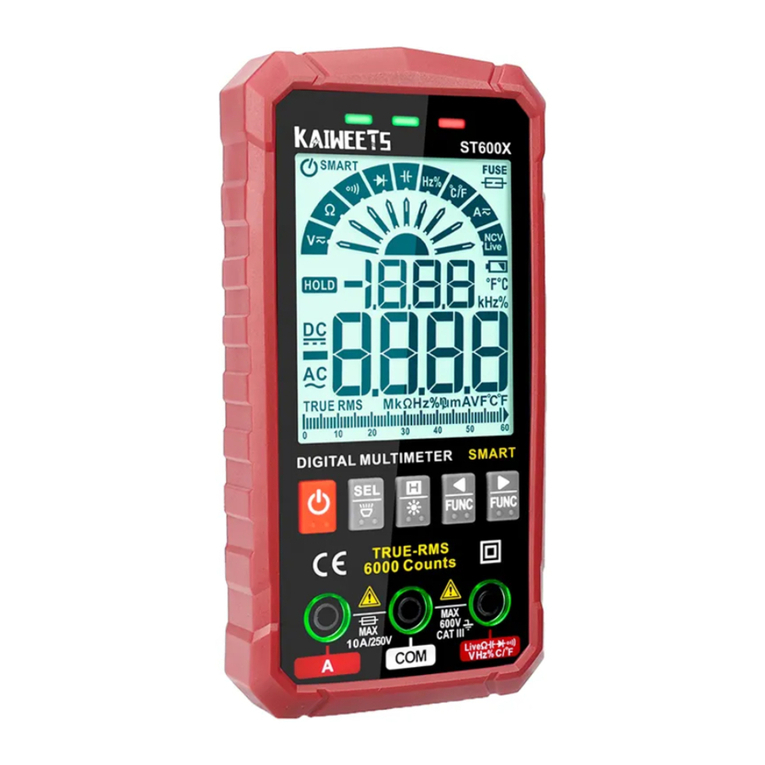
Kaiweets
Kaiweets ST600X user manual
